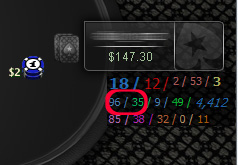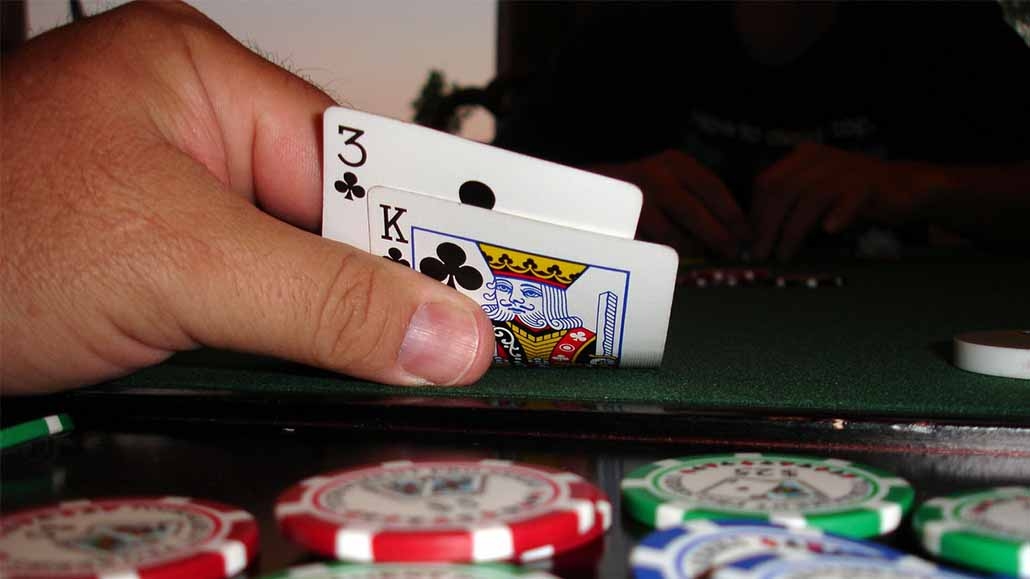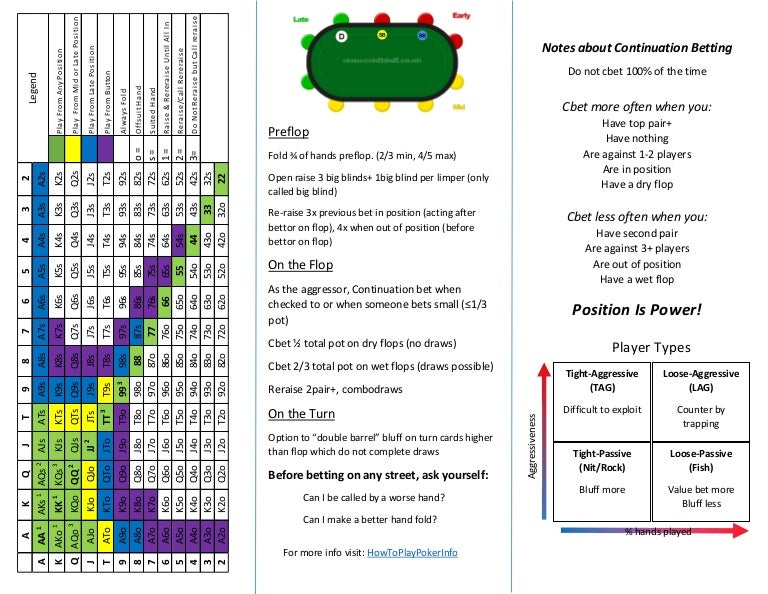A bet from a player on the flop who raised pre-flop is known as a continuation bet or simply a c-bet. That player has continued to seize the initiative, hence the term, continuation bet. The normal use of the continuation bet is by a player in position against a lone opponent who has checked on the flop. The use of a continuation bet is rooted in the wisdom that most of the time one’s hand does not improve on the flop. Therefore the first player to bet may take down the pot right then and there.
Over time the use of this strategy has almost become the 100% default action by many poker players. Right up front we will state that if players employ this poker strategy every time they have taken the lead pre-flop, they are continuation betting too frequently. When this is the case, what can be utilized selectively to one’s benefit can become a major leak. As in all of poker, predictability is analogous to stepping into the cross hairs of all but your most obtuse opponents.
Cbet Bonus Code Infos. New players have the opportunity to receive a 100% deposit offer up until €500 without entering a Cbet Bonus Code in February 2021. The offer is available for famous games from Evolution Gaming, Play’n GO and Pragmatic Play to mention a few. PokerTracker is an online poker software tool to track player statistics with hand history analysis and a real time HUD to display poker player statistics directly on your tables. Continuation betting is a solid poker strategy to employ when the criteria outlined above is in place. However, it should represent only one arrow in your quiver of ploys. As in all of poker, don’t use it every. The CBet Situational View breaks down the most common Continuation Bet poker situations researched and provides a graphical representation of the data. This makes the data easier to read than a standard report and less filters can be used to view the exact data you are looking for. ½ pot cbet needs 33% folds. 2/3 cbet needs 40% folds. ¾ cbet needs close to 43% folds. If you’re getting an average of 42-45% success (folds) you’re doing great with a 2/3 cbet and have probably maxed out your current cbet%. If it’s higher (like 46%+), then you can probably afford to do a little more cbet bluffing.
In this lesson we will attempt to explore the why, when and against whom this action should ideally be taken. We will also recommend some counter strategies for when your opponent is the one making a continuation bet.
The Purpose of Continuation Bets
As stated above, the strategy is based upon the fact that a hand is not usually improved upon by the flop so attacking your opponent with further aggression, regardless of your holding, can many times win the pot. It can also be used a reverse bluff when you hold a strong hand and would like to build the pot. The main purpose, however, is to win the pot immediately.
The Number of Opponents
The fewer opponents you are facing the higher your chances of success in winning the pot with a continuation bet. As a general guide, consider the following:
- C-bet almost 100% when heads up
- C-bet 50% when against two players
- C-bet 25% when against three players
Continuation betting against more than one opponent, while much less frequently, gives your game a degree of unpredictability. Although if there are four or more players then you’ll probably want to have hit the flop before sending more chips toward the middle – and a check may be in order.
The Texture of the Board
As the Mad Genius of Poker, Mike Caro, has stated… hold’em is a game of high cards while stud is a game of live cards. Keeping that counsel in mind, if the flop comes Jack, Queen and King there is a high likelihood that one of your opponents may well be holding a match to one of these wheel house cards. They weren’t calling your pre-flop raise with 6-3 offsuit!
The texture of the flop is critical to whether a c-bet is the play with the best expectation. Aside from high cards, be careful of coordinated boards that favor straight and flush draws. Ideally, you’ll want to see a ragged, rainbow flop.
Let’s look at a few examples. Suppose you raise with and get called by the button and the blinds. The flop comes :
Figure 1
This is not a good spot to c-bet. You’re against three opponents and your hand value is only an inside straight. You missed your high cards and flush potential and one of your opponents could have easily connected with such a flop. If checked to, then check and hope you get a free look at the turn. If you bet and then get raised by the button or check-raised by one of the blinds, you would have to fold, so see if you can hit your draw on the turn.
Let’s suppose you’re holding the same hand, yet this time you’re against a single opponent and the flop is dealt :
Figure 2

This is a completely different situation and if your opponent checks it’s a great time for a semi-bluff c-bet to either take the pot right then or if called you have two overs and the second nut flush draw. If you were facing more than one opponent then it would also be a good time to make a continuation bet, unlike the previous example.
You can also make a continuation bet when you flop a very strong hand, such a set. Remember that in poker it’s important to play different hands the same way. If you regularly make continuation bets when you whiff on the flop, you should also bet when you make a strong hand too – so as not to arouse suspicions. Your intention in poker is to manipulate your opponents and one advantage of frequently c-betting is that you will give your good hands some cover and disguise.

Bet Sizing
If you’re playing no-limit hold’em then you will also need to decide the size of your wager when planning a continuation bet. Many factors should contribute to your decision including: opponent playing tendencies, stack sizes and your own table image. You need to balance your bet size for two reasons. Understanding that the strategy is not fool proof… you don’t want to bet too small which will invite a call and to bet too large becomes foolhardy.
But it’s important to be consistent with your betting. Therefore your continuation bets should be the same size as any other post-flop betting and conventional wisdom seems to favor a bet size of at least half the pot. To bet less extends better calling odds to your opponent and to bet more becomes too costly when you run into an opponent that actually has a hand. This is not a hard and fast rule and you’ll find yourself making adjustments through experience, feel and the general nature of the game.
Your Opponents
While it is true that knowledge of how you believe your opponents will react is a universal poker criteria to successful play, when betting into an opponent with nothing, it is good to know how tight or loose he may tend to play.
In addition, just as you are making a play so may be your opponent. Is he savvy enough to be floating you? This is a play in which your opponent may suspect you are continuation betting so he just flat calls expecting you to check on the turn. If you do check after he calls your continuation bet, his intention is to seize upon your apparent weakness and bet to steal the pot.
The factors outlined above are the major criteria one should evaluate to determine the wisdom of making a continuation bet. In a perfect situation you should be in position against a single weak/tight opponent making a bet of about half the pot into a raggedy board. The half pot bet will offer him 3-to-1 odds which aren’t very good drawing odds. If you know your opponent is knowledgeable regarding drawing odds, this becomes a positive to offering him poor odds to a possible draw.
Countering the Continuation Bet
Now let’s take a look at the same situation in the mirror. Instead of aiming the shotgun at a lone opponent, we’ll imagine you are looking down the barrel of the continuation better. At the risk of sounding like a broken record, always be observant of your opponents in order to improve your decision making. Is he aggressive and loose or timid and tight or where in that range does he dwell? You know many players love to see a flop and then feel compelled to fire a continuation bet to end the action. Know your opponent’s tendencies – this knowledge pays dividends.
Reverse Engineering
Reverse engineering is a term used in many fields to describe a process wherein you first dissect a competitor’s product, marketing plan or just about anything in order to determine how it’s made or done with the intention of replicating it or improving upon it. The best way to combat an opponent who is continuation betting is to understand his thought process and, if appropriate, play back at him. Review the following checklist to determine if you’re being manipulated by an opponent’s continuation bet.
- Does he regularly, therefore predictably, continuation bet?
- Does his bet warrant a call based upon your hand?
- Based on his tendencies, is attempting to steal the pot?
- If he is stealing, should you raise, call, or fold?
Identifying the Meaning of Your Opponent’s Bets
There are many different types of bets in addition to continuation bets… value bets, probe bets, and semi-bluffs as examples. There is nothing worse than attempting to thwart what you believe is a continuation bet by calling all the way to the river only to face the ultimate revelation that your opponent was value betting the whole time.

Knowledge is power and it is up to you to observe your opponents betting patterns to understand just how they play the game. It is this knowledge that will help guide you to making quality decisions and when all is said and done – making quality decisions is what separates the winners from the losers.
Conclusion
Continuation betting is a solid poker strategy to employ when the criteria outlined above is in place. However, it should represent only one arrow in your quiver of ploys. As in all of poker, don’t use it every time you have been the pre-flop aggressor as you will become predictable and, therefore, exploitable. Instead, observe your opponents and determine who among them does not understand the wisdom of mixing up one’s game.
Related Lessons
By Tom 'TIME' Leonard
Tom has been writing about poker since 1994 and has played across the USA for over 40 years, playing every game in almost every card room in Atlantic City, California and Las Vegas.
This is the fourth episode in my Maximizing Your HUD series: Percentage Form and Color Coding for the Win. In this episode, I teach you about percentage form and how to color code your HUD stats. This helps for quick and easy reference and to find frequency exploits in a player’s game.
Listen to episode #60: Percentage Form and Color Coding for the Win
What do these numbers really mean? (4:00)
So far in this series I’ve discussed HUD usage for online poker. I gave you the essential elements that every HUD needs, as well as additional stats that you can use to exploit your opponents. I also talked about the popups and why they’re so useful, and I gave you some ways you can practice using your HUD.
But we haven’t really discussed how to understand and think about the numbers in your HUD. What does it mean when “Robbing Robbie” raises from the BTN 75% of the time, what’s it mean when “Fit-or-Fold-Francis” cbets only 20%, and how strong is “Debbie-Double-barrels” range of hands when she’s cbetting the flop and turn 70% of the time?
Percentage Form (4:45)
The first step to understanding the stats we see on the HUD is understanding Percentage Form. This is a shorthand way to describe a range of hands. Instead of saying, “He 3bets Jacks or better and AK” you can just say, “He 3bets 3%” and someone versed in percentage form will understand that.
Get Flopzilla Pro to help you learn ranges in percentage form.
Enter in a range of hands and it’ll tell you the % of hands that comprises. There’s a huge difference between a 10% range and a 50% range of hands, and understanding this is very useful for hand reading.
HUD’s give us the % of how often somebody does something, which helps us be more technical players rather than feel players. Knowing how often they perform certain actions, which tells us the likely range of hands they’re doing it with, helps us to make plans and develop plays to combat them.
Pre-flop Raise
Cbet Poker Definition
PFR is the % of the time that a player put in any raise pre-flop. This stat tells us how aggressive a player is.

Poker Cbet Percentage
If a nitty player has a tiny PFR of 5%, it means he only raises 5% of the time, or 1 in 20 chances. That’s only 77+, AK and AQs. He’s not even raising AQo, AJ, KQ, or 22-66.
Contrast this with an opponent who raises 30%, which is 6x more often than the nitty player opens, so it’s 6 out of every 20 chances. In the picture below, we see that 30% is any pp, A2s+, A7o+, every Broadway, K2s+, Q8s+, J8s+, 75s+ and 54s+.
That’s percentage form in action: looking at a stat and being able to understand what range of hands it correlates to.
3bet
This stat tells us how often the player decided to 3bet pre-flop. It’s another stat that looks at a players aggression and the % we see here is very telling.
You’ll often encounter people who only 3bet 2-3% of the time, which is JJ+ and AK. That’s it, just value hands.
Contrast this with somebody who 3bets 6% which is 99+ AQ and KQ. Quite a bit looser than the 3% 3bettor. And at 12% we’re looking at 55+, AT+ and KJ+. Now that’s getting aggressive with lots of hands that aren’t really doing so for value.
Cbet
Stat percentages tell you how often a player does something, but doesn’t always correlate to a range of hands. Cbet, or continuation bet, tells us how often the player bets at the flop given that he made the last raise pre-flop.
So a cbet of 20% means he bets the flop as the pfr only 2 out of every 10 times. A Cbet of 70% means he bets the flop 7 out of 10 times. That’s a huge difference, and one is obviously more aggressive than the other. But what do these two percentages really tell us?
We know that most ranges only “hit” the flop about 33% of the time. By hitting the flop I mean flopping TP+ or an OESD+. We know this by using a program like Flopzilla Pro that shows us how often a range of hands will hit flops. Here’s a screenshot of Flopzilla showing how a 25% raising range hits an average flop 34.2% of the time:
If an opponent has a cbet higher than 33%, you know he bets when he doesn’t hit the flop well, and the higher the % the more often he’s bluffing. If the cbet is below 33%, then you know he’s fit-or-fold and only fires when he hits the flop really well.
Color Coding for the Win (12:05)
Statistical Ranges
Color coding stat percentages helps to quickly spot frequency issues in your opponent’s game.
For PFR, I use a red/yellow/green/orange color scheme for my stat ranges. Red designates nitty stats, yellow is for reg stats, green for fishy and orange is for beyond fishy like LAG’s and donks.

So my own color coding ranges for PFR are:
- 0-8% and color coded red, which denotes a nitty player who raises infrequently
- 8-18% and color coded yellow, to denote a reg player who is raising somewhere in the range that’s considered to be optimal
- 18-24% and color coded green, which denotes a player getting too loose and aggressive with the hands they choose to raise
- 24-100% and color coded orange to denote a LAG or very donkish player
Another way that color-coding helps to spot frequency issues is when two different stats have opposite colors. For example, if their flop cbet is green (which is high and fishy or aggressive) and their turn cbet is low and red (which is nitty), then you know the opponent is turn honest and only bets here with the goods. This is like an opponent with a cbet of 70% on the flop then only 30% on the turn. Target these guys and take it away from them when they check the turn.
There isn’t a right or wrong way to color code your ranges, and even the ranges you select aren’t right or wrong. It’s just your opinion and whatever helps you exploit your opponents.
Ultimately, what I recommend you doing is writing down each stat in your HUD, and on a scale of 1-100, give thought into the ranges that comprise a nit’s, a reg’s, a fish’s and a LAG’s ranges.
My color coding ranges for:
3bet
- 0-6% red
- 6-9% yellow
- 9-16% green
- 16-100% orange
Cbet
- 0-50% red
- 50-66% yellow
- 66-100% green
Backgrounds and Font Sizes
Another part of color coding to make stats more user-friendly and quick to identify is background colors and font sizes. I increase the font sizing of the most important stats in my HUD, namely stack size in BB’s, VPIP and PFR.
The other thing I do is color code the backgrounds of stats that work well together. If you look at the screen shot of the 6max SNG & MTT SMART HUD below, you’ll see the following:
- Steal related stats all have a black background
- RFI, Fold to 3bet and 4bet are all teal
- Calling 2bet and 3bet stats are dark grey
- Cbet flop and turn stats are green
- And Fold to cbet flop and turn stats are on an olive background
Ultimately, it’s up to you to make your HUD as user-friendly as possible, and the goal should always be to make it so your HUD helps you exploit your opponents. That’s why you’re using the HUD after all.
Poker Against Cbet
Podcast Challenge (16:10)
What Is Cbet Poker
Here’s my challenge to you for this episode: Create some of your own color coding ranges for the most important stats in your HUD. I recommend doing this for the stats mentioned today, as well as Attempt to Steal, Fold to Cbet, # of Hands Played and VPIP. Take the time to create these on your own, giving careful thought to what the percentages mean. Use Flopzilla Pro to aid you in this process. This practice of thinking about each individual stat and what the possible percentages mean will be great for your ongoing poker development.
Other Episodes in the Maximizing Your HUD Series
Purchase the SMART HUD
Get 10% off my SMART HUD for PokerTracker 4. It includes a 1.5 hour webinar showing you how to use it. It’s the best HUD in the business, so don’t pass this one up.
Poker Betting Rules
And if you don’t own PokerTracker 4 yet, if you purchase PT4 through my affiliate link and forward me your email confirmation, I’ll send you my SMART HUD for free. What a deal!
- Counting Outs and Making Profitable Calls - February 4, 2021
- Don’t Respect the Player, But Always Respect the Math! - January 28, 2021
- Curiosity Kills Your Winnings - January 21, 2021